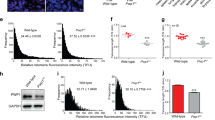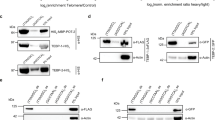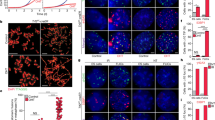Abstract
HOAP (HP1/ORC-associated protein) has recently been isolated1 from Drosophila melanogaster embryos as part of a cytoplasmic complex that contains heterochromatin protein 1 (HP1) and the origin recognition complex subunit 2 (ORC2). Here, we show that caravaggio, a mutation in the HOAP-encoding gene, causes extensive telomere–telomere fusions in larval brain cells, indicating that HOAP is required for telomere capping. Our analyses indicate that HOAP is specifically enriched at mitotic chromosome telomeres, and strongly suggest that HP1 and HOAP form a telomere-capping complex that does not contain ORC2.
This is a preview of subscription content, access via your institution
Access options
Subscribe to this journal
Receive 12 print issues and online access
$209.00 per year
only $17.42 per issue
Buy this article
- Purchase on Springer Link
- Instant access to full article PDF
Prices may be subject to local taxes which are calculated during checkout


Similar content being viewed by others
References
Shareef, M. M. et al. Mol. Biol. Cell 12, 1671–1685 (2001).
Fanti, L., Giovinazzo, G., Berloco, M. & Pimpinelli, S. Mol. Cell 2, 527–538 (1998).
Schmid, K. J. & Tautz, D. A. Proc. Natl Acad. Sci. USA 94, 9746–9750 (1997).
Mason, J. M. & Biessmann, H. Trends Genet. 11, 58–62 (1995).
Pardue, M.-L. in Telomeres (eds Blackburn, E. H. & Greider, C. W.) 339–370 (Cold Spring Harbor Laboratory Press, Cold Spring Harbor, NY, 1995).
Mason, J. M., Strobel, E. & Green, M. M. Proc. Natl Acad. Sci. USA 81, 6090–6094 (1984).
Pak, D. T. et al. Cell 91, 311–323 (1997).
Gatti, M. & Baker, B. S. Genes Dev. 3, 438–453 (1989).
Loupart, M. L., Krause, S. A. & Heck, M. S. Curr. Biol. 10, 1547–1556 (2000).
de Lange, T. Oncogene 21, 532–540 (2002).
Hopfner, K.-P., Putnam, C. D. & Tainer, J. A. Curr. Opin. Struct. Biol. 12, 115–122 (2002).
Siriaco, G. M. et al. Genetics 160, 235–245 (2002).
James, T. C. et al. Eur. J. Cell Biol. 50, 170–180 (1989).
Williams, B. C., Karr, T. L., Montgomery, J. M. & Goldberg, M. L. J. Cell Biol. 118, 759–773 (1992).
Cenci, G. et al. Genes Dev. 11, 863–875 (1997).
Acknowledgements
We are grateful to E. Koundakjian and C. Zuker for the EMS-induced lethal mutations screened to isolate cav, and M. Goldberg, B. Williams and E. Williams for participation in the screen. We are also grateful to J. Mason for the y RT terminal deficiencies, G. Reuter for the Su(var)2-5 mutation, S. Elgin for the C1A9 antibody, , M. Goldberg for the anti-ZW10 antibody and L. Ciapponi for critical reading of the manuscript. This work has been supported in part by a grant from the Associazione Italiana per la Ricerca sul Cancro (AIRC) to M.G.
Author information
Authors and Affiliations
Corresponding author
Ethics declarations
Competing interests
The authors declare no competing financial interests.
Rights and permissions
About this article
Cite this article
Cenci, G., Siriaco, G., Raffa, G. et al. The Drosophila HOAP protein is required for telomere capping. Nat Cell Biol 5, 82–84 (2003). https://doi.org/10.1038/ncb902
Received:
Revised:
Accepted:
Published:
Issue Date:
DOI: https://doi.org/10.1038/ncb902
This article is cited by
-
Low dose rate γ-irradiation protects fruit fly chromosomes from double strand breaks and telomere fusions by reducing the esi-RNA biogenesis factor Loquacious
Communications Biology (2022)
-
Key role of piRNAs in telomeric chromatin maintenance and telomere nuclear positioning in Drosophila germline
Epigenetics & Chromatin (2018)
-
A role for Separase in telomere protection
Nature Communications (2016)
-
The hnRNP A1 homolog Hrb87F/Hrp36 is important for telomere maintenance in Drosophila melanogaster
Chromosoma (2016)
-
Safeguarding genetic information in Drosophila
Chromosoma (2011)



